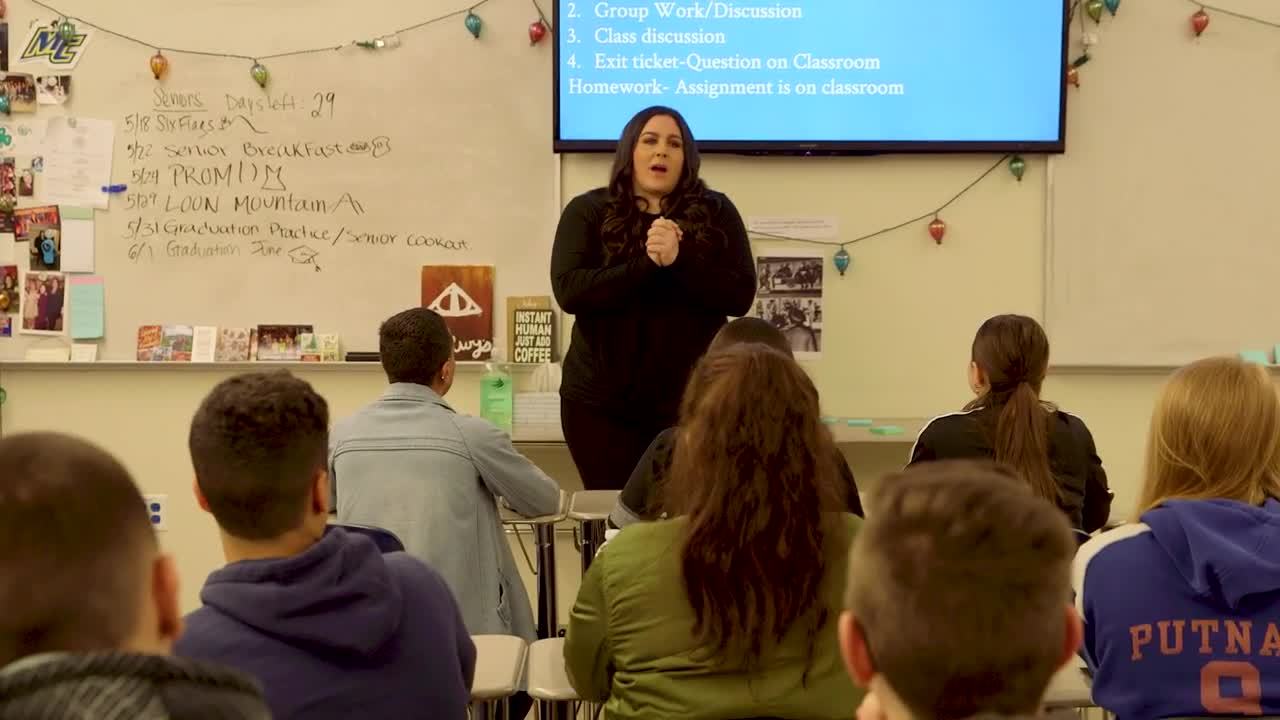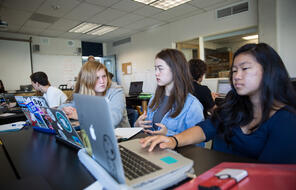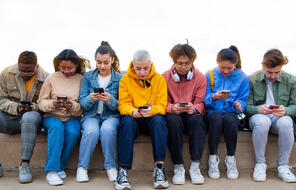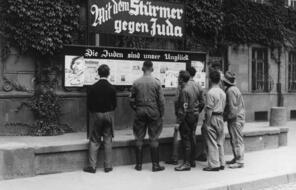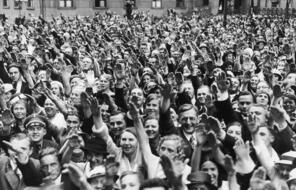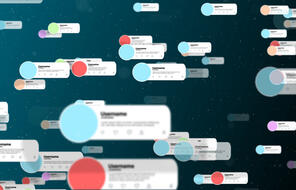We're going into our unit where we read the memoir Night by Elie Wiesel. It's really important for the students to get a solid background before we read any sort of work, but especially with Night, and we're talking about the Holocaust. Because a lot of the ideas, a lot of the events that unfold in the memoir, they'll need to have a general understanding of the historical time period because you can't just throw students into a time period that they're not familiar with without giving them some background.
We've talked about propaganda. They've definitely talked about propaganda in other classes.
So today we're going to continue our study of the Holocaust in preparation of reading Night. And we're going to look at propaganda. Does anybody need a refresher on what we talked about? Thank you. OK, so someone want to help him out? Henry?
I remember we talked about the way that Jews and other people were treated during this time, and the policies and other changes put in place that kind of sparked the beginning of the Holocaust, such as decisions made to get rid of things like Jewish-run businesses and other things like that.
Mm-hmm, good. So today you guys are actually going to be looking at some actual propaganda posters and images of people that the Nazis used as propaganda.
I do anticipate a few challenges about this lesson. And I think the most challenging thing you deal with when you deal with the Holocaust is the outright discrimination and prejudice against, specifically in today's lesson, the Jewish population. And I think that students today are very accepting and they're very open to people's differences. I think that kids really do have a hard time dealing with that because it's against what they're taught in our culture. So I think that one of the challenges is definitely dealing with how do you deal with students presented with material that really goes against everything that they believe in.
What I'm going to have you do is something very different, today, than we've done before. Everybody is going to need a writing utensil. What we're going to be doing is called a gallery walk. I'm going to ask everybody to get up, and you're going to walk around the room, spread yourselves out.
And you'll notice that there's Post-its kind of all around where the posters are. Take a Post-it, and I'm going to ask you to do one of three things. You're either going to comment on the picture, you're going to ask a question about the picture, or you can just come up with a phrase or a word that you think of when you look at the picture.
Some of the pictures do have German writing on them. And I did kind of translate for you underneath. So make sure you read the captions. Take your time looking at the pictures. Really kind of try to take them in. And then write your comment, question, or your phrase or word, and then leave it up on the wall near the picture.
Make sure that you get every single one. Take your time looking at them. Really think about what you want to write. And then once we're all done-- I'll give you about 15 minutes for this-- once we're all done, we're going to get back together. So get up and walk around.
[INDISTINCT CONVERSATION]
All right, everybody, so good job with that activity. You guys had lots of thoughts. I was reading some of the things you wrote-- really good questions you asked, really good observations.
So now what I'm going to have you do is work together in groups. I need you in groups of four or five, and I need five total groups. I'm going to assign you one of these five questions to talk about in your group. I'm going to give you some time to talk about it. Somebody should be writing some notes down, and another person should be nominated to speak out to the class. And so you guys can decide within your groups who will do that. Once you get into your groups, I'll assign you a number, and then you'll discuss, and we'll come back together, and your reporter will share out.
Five groups total.
Let's see, why was it so important?
Well, for one thing, they needed it in order to convince most of the citizens to follow some of their more intense ideas that they wouldn't be able to get them to follow directly.
The influence through the children and different ways, through advertisements and through children's books.
And even just teaching it in schools, too.
Yeah. And the audiences were directed towards the everyday citizens.
It's easier--
You have so many more platforms--
Yes, it's way easier to share, it's easier to rile people up. Because people are already on edge with history between countries.
So let's start with the first question. So the first question we had was, who were the audiences for these messages, and how were the messages conveyed? So group 1, what did you have to say about that?
We said that the audiences of these messages are everyday German citizens. And the messages are conceived in positive ways by showing or stating "joining the Nazi party will give you protection." And they target some of their propaganda towards the youth because they know the youth would be the next generation. So by brainwashing them to believe in the Nazis, they already will have a huge audience.
And then they conveyed this message through posters, paintings, teaching children negative things about the Jews in schools, advertisements, and children's books.
Good-- really good. So I like that you focus on-- I think that you focus on the Hitler Youth. And I'm assuming the children's book kind of had something to do with your answer.
So yeah, so it's really important to, when you're looking at these, to remember that it's not only adults that we're trying to convince of these messages. It's children. And why would-- and this is open to everybody-- so why would the propaganda posters that geared themselves towards children, why are those effective, and why would those be used?
Children are not mature, so they're not great at making decisions for themselves. So if they get repeatedly taught, hey, you should believe that the Jews are bad people, they'll start to believe it. Because unlike adults, where adults can tell whether something's right or wrong, children aren't as good about that. So they're kind of easier to convince.
Easier to manipulate, right?
Based on the images you analyzed, how do you think the Nazis used propaganda to define the identities of individuals and groups? And what stereotypes did it promote?
Nazis were trying to distinguish themselves from the Jews while looking like the dominant race. And then in the certain cases, like the picture of Hitler holding up the Nazi flag as a knight was showing himself as the leader, or kind of the overall king of the land or something.
And then it was like-- the other one was that all the Jews are worthless and they have no place in the world, kind of like those signs said, and how it was like "all Jews must die" and stuff.
I liked what you said when you said Hitler and the Nazis tried to distinguish themselves from others. So that idea that there's something about them that's special or more important than others. And what poster exactly were you referring to when you were thinking about that idea?
I was mostly thinking about the knight picture, and how it kind of pictured Hitler as kind of, just their knight in shining armor over the land.
When I saw that, I kind of thought that the portrait portrayed him to be superior. So I thought-- and especially with the Nazis, they thought they were the superior race. And I thought that was a good portrait that portrayed that.
I think it's really important for the students to be able to grasp something like the Holocaust. I don't necessarily love the question, "what would you do if you were here?" But more, maybe put yourself in this kind of mindset, and kind of look at the experiences of other people who would be in your position during this time period. This happened to people who were just like them. And people who witnessed this event were just like us.
I definitely think that my students met the learning outcomes for today's lesson. I wanted them to be able to speak intelligently about the propaganda images that they were faced with, and I also wanted them to engage in a meaningful discourse with their peers, and share out that important information that they gathered from their peers, giving the students a strong foundation in, think about the choices we make, and think about the way we react to the things that happen around us. And I think, as true with any sort of topic that you go through in class or book that you read, it's really important for them to connect. Because if they don't connect to something, then they don't care about it.
